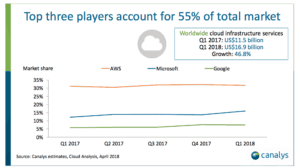
There is no doubt that businesses are becoming more comfortable with the idea of placing mission-critical workloads in the public cloud. In a 2017 McKinsey study, less than half (40 percent) of companies had more than 10 percent of their workloads on a public cloud platform. However, 80 percent planned to have more than 10 percent on a public cloud platform within three years.
The low penetration of workloads in the public cloud is a sure sign that business leaders aren’t yet as comfortable with the public cloud as they are with on-premises and private hosted clouds. However, the dramatic jump in the planned use of public cloud platforms shows that the benefits of the public cloud (flexibility, cost savings, etc.) are causing many to take a second look.
What is the Public Cloud?
For all practical purposes, the public cloud has become somewhat synonymous with hyperscale cloud platforms such as AWS and Azure. But, perhaps, the most important distinction between a public cloud and a private cloud is that resources are shared on a public cloud whereas they are dedicated to one organization in a private cloud.
Clearly, trust in the public cloud is improving, but whether or not these business leaders realize their plans for leveraging the public cloud (or exceed them) will depend in large part on overcoming any lingering concerns.
Four vital questions to consider before migrating to the cloud
We can break these concerns down into three main categories: security and compliance, performance, and cost-optimization. When an organization considers moving a workload to the cloud (any cloud), they typically need to answer four questions:
- Can I meet my security and compliance obligations using this cloud?
- Will I get the performance I need?
- How can I be sure I am realizing the greatest return for my investment?
- Do I have access to the in-house or thrid party skills I need to stand up and maintain these cloud resources in a way that best helps me achieve my objectives and mitigate my risks?
There are a wide variety of public clouds available, but two vendor platforms dominate the market today: AWS and Azure. As of this moment, Amazon (AWS) is pretty far ahead, but Microsoft (Azure) is gaining ground quickly. At Connectria, we’ve made the decision to fully support both platforms to allow our customers to choose the public cloud option(s) that fit their workloads best.

You can contact a Connectria expert directly for a one-on-one discussion about your workloads and public cloud concerns. Both of these papers will help you answer the four important questions as well as provide additional considerations specific to the platform. One of our advisors would also be happy to help provide perspectives from our work helping customers of all sizes and across industries choose and implement the cloud environment that is right for them.
Topics
Keep Reading
Prepare for the future
Tell us about your current environment and we’ll show you the best path forward.
Fast track your project. Give us a call.






